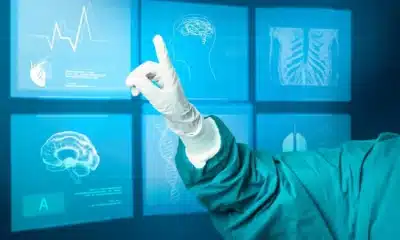Health
Remote Care and the Age of Chronic Care Management
Published
2 months agoon
By
MUNJAL BLOG
The most urgent health issue of the present day is chronic diseases. Diabetes, heart failure, hypertension, COPD, and kidney disease are some of the common ailments that occupy most of the hospitalizations and healthcare expenditure in the world. They cannot be treated through only one form of therapy, as acute diseases; they need to be observed and subjected to lifestyle modification and coordinated treatment.
Conventional healthcare models, which are designed on the basis of short appointments and episodic intervention, are ill-matched with chronic illness. The patient is usually left to work on his or her condition independently of the visits which makes adherence poor, complications are therefore avoidable, and the patient is prone to rehospitalization. Chronic care management was one of the solutions, and it focuses on constant support, inter-provider coordination, and upstream interventions. Modern day technology is advancing this idea by incorporating remote care and remote patient monitoring systems into the daily practice.
The definition of Chronic Care Management
Simply, chronic care management is all about consistency and coordination. It does not just stop at diagnosing and prescribing; it makes sure that patients are provided with frequent follow-ups, educational and supportive measures, to be able to cope with their conditions successfully. To providers it consists of creating a system where the primary care physicians, specialists, nurses and other caregivers are joined on a single plan of the patient. To the patients, it amounts to not being left alone to figure out the intricacies of the long-term illness.
This method has been accepted in most healthcare systems. To illustrate, the health services in the United States, through Medicare, reward chronic care management treatment services because of the benefits of chronic care management to patients with several conditions. However, as policy has laid the groundwork, technology is now making chronic care management available at the scale it could not ten years ago.
The Remote Patient Monitoring Platforms Role
The modern chronic care management is built on the remote patient monitoring platforms. Through these platforms, wearable devices, mobile applications, and home-based sensors are connected to the healthcare providers to form a continuous flow of health data. Patients are able to monitor blood pressure, glucose, weight, oxygen saturation, or heart rhythm at home, and the results are immediately sent to the patient care team.
In the case of patients who suffer from heart failure, sudden weight gain can also be an indication that the body is retaining fluid, and the patient may be admitted to the hospital. Remote monitoring will identify this at an early stage, and the doctor will be able to make necessary changes to the medications prior to the crisis. Continuous glucose monitoring offers real-time information to diabetic patients and provides direction for patient behavior and interventions by the provider. Rather than being dependent on the self-reported data, the providers are now provided with objective data, which will be time-stamped and which will be reflective of the patterns and trends.
Such visibility makes chronic care management more of a proactive model as opposed to a reactive model. The providers do not have to wait until patients come with complications but can implement measures at an early stage, avert the aggravation of the situation, and maximize the treatments in real-time.
Enhancing Accountability and Patient Engagement
Patient adherence is one of the biggest barriers to chronic care management. The drugs should be taken, and the diets and exercise have to be integrated into day-to-day life. Lack of accountability will make most patients lose interest in their treatments, which will result in poor outcomes.
Remote patient monitoring platforms promote engagement by providing patients with access to their personal data. They also tend to be more motivated to maintain healthy behaviors when the participants have an opportunity to see the improvement in their state, e.g., a drop in blood pressure or a steady glucose level. Certain platforms also contain notifications, the motivation courses, and personal communication lines with participants, which also strengthens obedience.
To patients, this would make them feel that they have a partner instead of feeling isolated. No longer are they left to wonder whether they are coping with their condition in the right direction; they have the knowledge that their healthcare team is keeping a watch on them and guiding them all along the way.
Less Hospitalizations and Healthcare Costs
One of the most expensive components of chronic disease is that of hospital readmissions. When a patient is discharged following a heart failure episode, he or she may get back to the hospital in a few weeks if the condition is not properly attended to. These readmissions are reduced significantly by using chronic care management, which is reinforced by remote patient monitoring.
With the help of early warning signs and timely interventions, healthcare teams will be able to address issues at home instead of in the ER. This does not only enhance the quality of life of patients but it also reduces the financial burden incurred by the healthcare systems. Research has always indicated that chronic care management programs are cost effective as they decrease the number of hospital admissions, emergency room visits and morbidity.
Issues that remain to be tackled
Chronic care management has its challenges even though it is promising. Not everyone with a specific patient will be tech-savvy, and others will be reluctant to use monitoring equipment. The providers should provide support and training to facilitate adoption. Another issue is data privacy; remote patient monitoring platforms receive sensitive health data that should be safely stored and transferred.
Systemic problems include systemic challenges like reimbursement models which is yet not fully embraced to include remote monitoring, and the possibility of interoperability among various platforms and electronic health records. In the absence of smooth integration, precious patient data will be isolated and not fully utilized.
You may like


How to Plan a 48-Hour Luxury Trip to London

Benefits of Partnering with an Expert Foundry

Choosing the Right Supported Independent Living Option for Your Needs

Why Companies Worldwide Are Hiring Power BI Developers

Experience Pure Android Gameplay with MuMuPlayer Emulator

A Guide To Solar PV For Homeowners

How to Convert a Historic Building into a Hotel: a 2025 Guide

How You Can Integrate AI into Your Small Business For Faster Growth

File Recovery on Android: Myths vs. Facts

Cooler, Safer, Clearer: Why Quality Window Tint Is a Smart Upgrade in 2025

Carol Kirkwood’s Journey: Her Real Age, Husband, Career, and More

Revolutionizing Healthcare: The Emergence of AI-Driven Analytics

How Machine Learning and AI are Redefining the Future?

Aliza Barber: Meet Lance Barber’s Wife, Age, Life, Profile, Career and Net Worth

Evelyn Melendez: Jordan Knight’s Wife Bio, Marriage, Family, Career and Net Worth

Ilan Tobianah Biography: Family, Marriage, Lifestyle, Career and Net Worth

Who was Alice Marrow? Everything to Know About Ice-T’s and His Mother

King Von’s Autopsy Report: The Truth Behind the Tragic Death

Meet Otelia Cox: The Supportive Wife of Tony Cox – A True Fairy Tale Romance

Tea Leoni and Tim Daly Split – A Closer Look at Their Relationship and Breakup

How to Plan a 48-Hour Luxury Trip to London

Benefits of Partnering with an Expert Foundry

Choosing the Right Supported Independent Living Option for Your Needs

Why Companies Worldwide Are Hiring Power BI Developers

Experience Pure Android Gameplay with MuMuPlayer Emulator

A Guide To Solar PV For Homeowners

How to Convert a Historic Building into a Hotel: a 2025 Guide

How You Can Integrate AI into Your Small Business For Faster Growth

File Recovery on Android: Myths vs. Facts

Cooler, Safer, Clearer: Why Quality Window Tint Is a Smart Upgrade in 2025
Category
Trending
-

 News3 months ago
News3 months agoCarol Kirkwood’s Journey: Her Real Age, Husband, Career, and More
-

 Health2 years ago
Health2 years agoRevolutionizing Healthcare: The Emergence of AI-Driven Analytics
-

 Technology2 years ago
Technology2 years agoHow Machine Learning and AI are Redefining the Future?
-

 Celebrity2 years ago
Celebrity2 years agoAliza Barber: Meet Lance Barber’s Wife, Age, Life, Profile, Career and Net Worth
